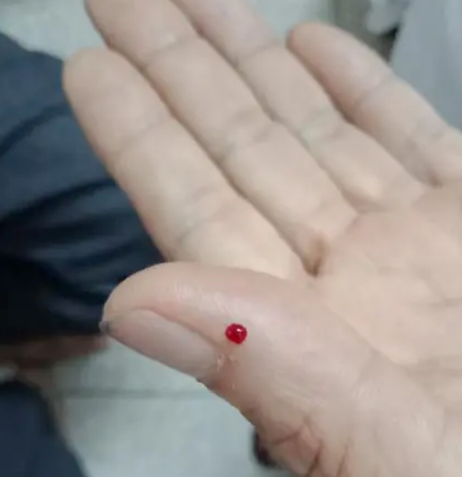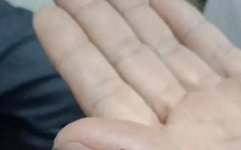
Bloodletting Technique
1. After identifying the blood points, quickly puncture the wrist area, aiming for 6 to 9 punctures within one second.
2. For engorged vessels, a single needle prick should yield blood, which will generally spurt out. Be prepared to avoid splattering dirty blood.
Reactions After Bloodletting
1. 80% of patients feel relaxed and comfortable immediately after bloodletting, while 20% may experience increased pain. Those who feel increased pain tend to heal much faster than those who feel immediate relief.
2. If there is no sensation after 5 to 10 bloodletting sessions, further bloodletting is not advisable.
Timing of Bloodletting
1. For inflammation and acute pain patients, bloodletting can be performed once a day, and after alleviating symptoms, once every 3 to 5 days.
2. For chronic patients, perform bloodletting every other day, and once every 5 to 7 days after seeing results. Bloodletting can be done at the cupping site followed by cupping for 15 to 20 minutes.

Contraindications for Bloodletting
1. Patients with severe bleeding or those prone to subcutaneous bleeding.
2. Severe heart disease.
3. Patients with sexually transmitted diseases, skin diseases, or skin ulcers.
4. Pregnant women or those menstruating, and patients with leukemia should not undergo bloodletting.
5. Patients who are overly hungry, overly full, frightened, or excessively tense should not be treated.
6. For patients with liver disease, bloodletting must be performed with caution (as with any other treatment). Avoid contact with the blood, especially on open wounds, to prevent infection.
Emergency Treatment for “Needle Shock”
1. Immediately warm the patient’s Dazhui (大椎) point with your palm.
2. Pinch the Ren Zhong (人中) and He Gu (合谷) points simultaneously.
3. Then press Nei Guan (内关), Yong Quan (涌泉), and Tai Chong (太冲). If possible, have the patient drink a cup of warm sugar water or glucose water immediately.
4. Have the patient lie down (with their head lower than their feet).
Diagnosis Through Bloodletting
1. If the blood is very light, it indicates inflammation or an early stage of illness. If the blood is dark and thick, it indicates a chronic condition with blood stasis.
2. If pain decreases during the day after bloodletting but worsens at night, it indicates blood stasis, and another bloodletting session is necessary until relief is achieved.
Clinical Experience
The experiences of bloodletting in textbooks are very effective and should be studied and applied diligently. The following experiences are equally effective.
1. Treatment for Cerebral Hemorrhage (Stroke):
For patients with bleeding, they will often be unconscious. Puncture the Yin Tang (印堂), Tai Yang (太阳), Tai Chong (太冲), and the ten fingers to draw 1 to 5 drops of blood, which can help them regain consciousness sooner and reduce the severity of paralysis.
Remember: If a patient is unconscious for more than 24 hours, the rate of paralysis is over 90%. If it exceeds 72 hours, there is a 100% chance of post-stroke sequelae, which are very difficult to treat. Therefore, promoting early consciousness is a priceless secret technique. Once the patient wakes up, puncture Dazhui (大椎), Qu Chi (曲池), and Wei Zhong (委中) to draw blood, and the patient may have a chance of recovery.
2. Sciatica
If it is related to gallbladder meridian pain (outer thigh pain), carefully examine the Yang Ling Quan (阳陵泉) and Feng Long (丰隆) points for engorged vessels. If present, bloodletting may lead to recovery.
3. For Patients Prone to Boils and Abscesses
For those who are prone to boils and abscesses, bloodletting should be performed at the heart point.
4. Early Stage of Conjunctivitis or Stye
For early-stage conjunctivitis or stye that has not yet suppurated, puncture the Tai Yang (太阳) point to draw 7 to 9 drops of blood, and also draw 3 to 5 drops from the tip of the middle toe. Bloodletting today can lead to recovery by tomorrow.
5. Rheumatism
For severe rheumatism in the legs, puncture 3 inches beside the third, fourth, and fifth thoracic vertebrae, and bloodletting will yield significant results. Many patients with severe conditions have recovered after just 1 to 2 sessions.
6. Gastric and Duodenal Ulcers
Puncture the blue veins from the foot’s Nei Ting (内庭) to Jie Xi (解溪) area, and near the outer ankle. For gastric ulcers, look for blood vessels within 0.5 inches above and 2.5 inches below the Tiao Kou (条口) point.
7. Chronic Nephritis
(1) Bloodletting at the Ru Yu (儒俞) point can help if there is yellow fluid; once the yellow fluid is gone, the patient will recover.
(2) Around the kidneys.
(3) Bloodletting around the navel (do not puncture the center of the navel).
8. Bloodletting for Hepatitis
Puncture Yang Jiao (阳交), Zu San Li (足三里), Qu Ze (曲泽), Yang Ling Quan (阳陵泉), and San Yin Jiao (三阴交).
9. Cirrhosis with Ascites
Use the acupuncture points for hepatitis plus: Shen Yu (肾俞), Yao Yu (腰俞), Tiao Kou (条口) (0.5 inches above and outside), and Gan Yu (肝俞).
10. Effective Points for Hemorrhoids
(1) Chao Jiao (龊交) point (inside the mouth) can be found by locating the white spot; 1 to 3 sessions can lead to recovery.
(2) For patients with red, swollen, and ulcerated anal areas, bloodletting at Wei Zhong (委中) will reduce pain.
11. Insomnia
(1) Shen Men (神门), Xing Jian (行间), Zu San Li (足三里).
(2) Dazhui (大椎), Shen Dao (神道), Zhong Wan (中脘), followed by cupping.
12. Cervical Spondylosis:
Pain points, Tian Zong (天宗), Jian Zhen (肩贞), and Chi Ze (尺泽) points.
13. Chest Internal Injuries
For any internal injuries in the chest, bloodletting must be performed at Dazhui (大椎), Jian Jing (肩井), and then at the injury site.
14. Shoulder Periarthritis
Puncture the Shen Guan (肾关) point (1.5 inches below Yang Ling Quan) and Chi Ze (尺泽) point; results can be seen after one session.
15. Acute and Chronic Throat Diseases
Dazhui (大椎), Er Jian (耳尖), ear back veins, Shao Shang (少商), Qu Chi (曲池), Tai Yang (太阳); bloodletting will reduce pain.
16. Impotence
(1) Bloodletting at Shen Yu (肾俞) and Fu Liu (复溜), and cupping at Guan Yuan (关元) and Bladder Shu (膀胱俞) for 15 minutes.
(2) Bloodletting at San Yin Jiao (三阴交), Ming Men (命门), cupping at Shen Yu (肾俞), and Xue Hai (血海).
17. Hypertension
Puncture Tai Yang (太阳), Dazhui (大椎), ear tip, ear back veins, and Qu Chi (曲池); blood pressure will drop immediately after bloodletting. Note: Do not drink water within one hour after bloodletting, or the effect will be diminished.
18. Asthma
(1) Bloodletting at Dazhui (大椎), Lung Shu (肺俞), Feng Men (风门), Gao Mang (膏盲), and Lie Que (列缺).
(2) Zhong Fu (中府), Dazhui (大椎) followed by cupping for 15 minutes.
19. Hyperlipidemia
Dazhui (大椎), Tai Yang (太阳), Yao Shu (腰俞), Wei Zhong (委中), and Qu Chi (曲池).
20. Rheumatic Heart Disease
Yang Jiao (阳交), Chi Ze (尺泽), and Tai Yang (太阳).
21. Pterygium of the Eye
Shao Ze (少泽), Zhi Yin (至阴), ear tip, Dazhui (大椎); perform every other day for a 10-day course.
22. Otitis Media
Bloodletting at the outer ankle joint.
23. Epilepsy
Formula 1: Tai Yang (太阳), Qu Chi (曲池), Wei Zhong (委中), Yang Jiao (阳交).
Formula 2: Shao Shang (少商), Ren Zhong (人中) for bloodletting; Liver Shu (肝俞), Dazhui (大椎) followed by cupping for 15 minutes.
Formula 3: Locate pain points at the lower part of the cervical vertebrae and use plum blossom needles to draw blood from the Nei Guan (内关) point.
24. Mental Illness
Tai Yang (太阳), Qu Chi (曲池), Wei Zhong (委中), Shu Chong (术冲), Yang Jiao (阳交), Feng Long (丰隆), and Heart Shu (心俞); bloodletting followed by cupping.
25. Key Points for Back Diagnosis
The spine should not have protruding blood vessels; if present, it indicates a pathological site. Patients with chronic illnesses will often have black moles on their backs.
The Secret of Bloodletting
For diseases that have not healed after prolonged treatment, when all methods seem ineffective, bloodletting should be performed on the engorged vessels at the ankles, elbows, wrists, and knees, which can yield unexpected results. This is my personal experience.
Reminder: The various prescriptions and remedies mentioned in this article are for reference and learning purposes only and should not be used as prescriptions. Please do not use them blindly; this platform does not bear any responsibility for any consequences arising from their use!
 Acupuncture Point Inquiry
Acupuncture Point Inquiry
 Tongue Diagnosis Atlas
Tongue Diagnosis Atlas
 60 Shocking Secrets from the Medical Field
60 Shocking Secrets from the Medical Field
 Qu Li Min’s From Head to Toe: Talking About Health
Qu Li Min’s From Head to Toe: Talking About Health
 Complete Video Series on Pediatric Tuina
Complete Video Series on Pediatric Tuina
 Complete Video Series on Tuina Basics
Complete Video Series on Tuina Basics
 Complete Video Series on Moxibustion Therapy
Complete Video Series on Moxibustion Therapy
 Complete Video Series on Tuina Techniques
Complete Video Series on Tuina Techniques
 Every like you give, I take seriously as a sign of appreciation.
Every like you give, I take seriously as a sign of appreciation.

